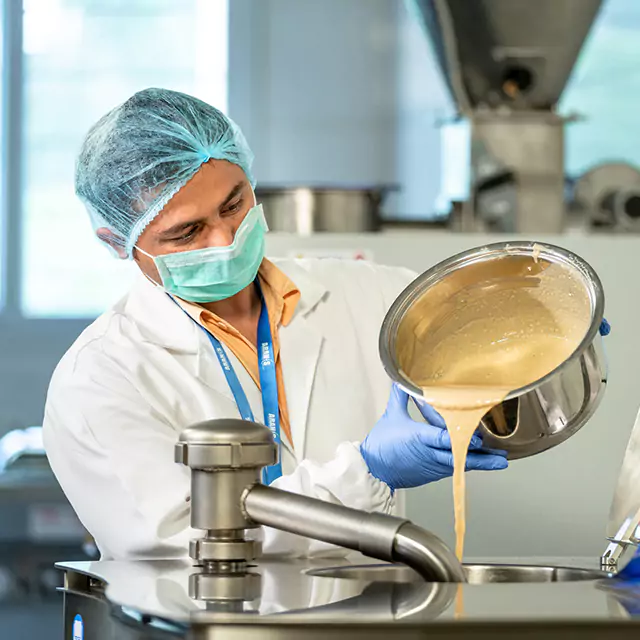Ingredient innovation with consumers
and our customers in mind
Ingredient functionality, for us, is all about understanding what our ingredients add to the food matrix, in terms of their physical and chemical functionalities. Agricultural products, by definition, are natural and will always have a slight degree of variance. Origin and growth process combined with post-harvest processing will help determine the functionality of our raw materials and our ingredients. Knowing that, we think alongside our customers about how they can best incorporate our ingredients in their end-applications and help them make their ideas and ambitions for new products real.
Winning the battle for market share starts with meeting our customer’s needs for great tasting, great looking products with an optimal mouthfeel. But great taste, snap and bite, with an appealing product color, do not always match the increasing consumer desire for fewer additives in their food products. This is why we are always looking for opportunities to develop natural ingredients without the use of additives to suit clean label applications. Our nut ingredients deliver incredible texture, taste and nutrition without any complex artificial ingredients.
Several natural ingredients across our portfolio can help you recover missing elements like color and flavor. Take our spices – they can help formulators create a realistic, meat-like color in plant-based alternatives, all while maintaining a clean-label and adding to the overall flavor profile. And then there is cocoa. Cocoa powder can be used as a coloring agent in vegetarian/vegan products: deZaan Fresco Cacao F11FR is a non-bitter, mild cocoa powder that can be used to create fresh chocolate plant-based yogurts.
Another example is the development of our “TrueDark” cocoa powder, whilst staying away from color enhancing additives. And there is more. How we do it? If you work with us, we will share our darkest secrets!
Across our portfolio, health and nutrition benefits – both long-standing and emerging – are a common denominator. The nutritional value of our nuts, the macro and micronutrients of dairy, the theobromine and antioxidants in cocoa and the health associations of many spices really form a wealth of opportunities for our customers. We are always looking to see how these benefits can be protected and enhanced during the manufacturing process, whilst still tasting great.
With the world’s resources under pressure, we seek to get everything we can from our raw materials. Not only to create value for our farmers, but also to minimize greenhouse gas emissions. This often uncovers new and exciting opportunities. Our sweet and fruity cascara for instance, was developed out of coffee husks, which is the skin and pulp of the coffee cherry fruit. The ingredient is now used for beverage infusions and concentrates across multiple applications to meet the growing trend for healthy indulgence.
Read ofi news
By Andrew Brooks, Head of Cocoa Sustainability, olam food ingredients (ofi)
This week, the world’s attention turns to a heavy burden that can damage a child’s Health and Education: child labour. In ofi's cocoa business, we are focused on solving this problem every day.
Most child labour in cocoa relates to children carrying out hazardous tasks on the family farm, distinct from the much rarer issue of forced labour, and has no one cause. Labour laws can be misunderstood, and schools might be located far away. Even if there is a school nearby, children may not have the documents they need to enrol. When combined with rural poverty, many parents think their child’s time is best spent helping on the farm. And now, these cocoa-growing communities are also battling a global health pandemic.
We’re working to tackle each of these challenges in turn. Under our Cocoa Compass sustainability ambition, we aim to completely eradicate child labour from our direct supply chain by 2030 and ensure farmers’ children can access the education they are entitled to. In 2020, we reached the critical milestone of rolling out child labour monitoring across 183,000 households in nine countries.
There is still a lot to do, and collaboration with our customers, national governments, and civil society is essential. For example, we recently asked the Fair Labor Association (FLA) to assess the extent to which cocoa farmers and their families have benefited from our sustainability programmes in Côte d’Ivoire, their perception and satisfaction with these interventions, and help to refine our approach further.
Using a due diligence methodology called Social Impact Assessment, the FLA collected extensive data and interviewed over 450 people from ten cocoa communities, including women and children. It found that of all our efforts to tackle child labour, the setting up of child labour monitoring and remediation and enabling access to education are the most advanced and have the most significant impact.
It also revealed that over two-thirds of those interviewed think child labour is on the decline in their community, and 80% believe that the interventions by ofi and our partners are contributing to protecting children.
There are areas for improvement. The FLA suggested we provide additional support to help farmers access affordable labour. And ensure greater follow-up with Village Savings and Loans Associations to maximise their ability to promote child protection.
We know that combining our efforts through multi-stakeholder partnerships, championed by local and regional governments, and supported by international finance institutions, is the best way to create the kind of long-term systemic change needed to reach universal school attendance
and graduation for children in cocoa communities.
This World Day Against Child Labour reminds us that if we want to put children first in cocoa, we must be open to testing new approaches and adapting our efforts based on what works best. The future of a cocoa generation is at stake if we don’t.







